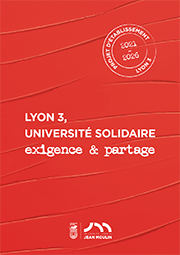AccueilRechercheLes productions scientifiquesThèsesThèses soutenuesThèses soutenues - 2006-2020Thèses soutenues - 2015
-
Partager cette page
- Recherche,
ULLMANN Gabriel
Les installations classées pour la protection de l'environnement (ICPE). Des origines de la nomenclature à l'enregistrement.
Thèse en Droit mention Droit public soutenue le 29 septembre 2015
Le décret impérial du 15 octobre 1810 a fondé la première réglementation nationale sur les établissements classés. Il a jeté les bases de notre droit de l’environnement industriel et a créé la première nomenclature. L’analyse de plus de 140 textes de nomenclature parus depuis l’origine a permis de comprendre certaines évolutions de la société, tant la nomenclature constitue, depuis plus de deux siècles, un puissant marqueur sociétal. De plus, la nomenclature conditionne fortement l’effectivité de la loi. Si le décret a initialement visé à privilégier la liberté d’entreprise, il a progressivement évolué vers un droit plus protecteur des tiers, notamment en faveur du droit de propriété. La loi du 19 décembre 1917 sur les établissements classés a renforcé ce dispositif dans un sens globalement plus favorable aux tiers, puis à l’environnement. Mais aussi, au profit de l’hygiène et de la sécurité des travailleurs qui avaient été délaissées. En contrepartie, la loi a rompu avec le principe de l’autorisation préalable en introduisant le régime de la déclaration, au bénéfice des exploitants. La loi du 19 juillet 1976 relative aux installations classées pour la protection de l’environnement (ICPE) a repris ces dispositions, en les modernisant mais en innovant peu. La nomenclature a vite connu de multiples transformations, qui se sont traduites par de nombreux déclassements d’établissements. Ainsi, le régime déclaratif n’a pas cessé de croître, tandis que la création en 2009 de l’enregistrement, intermédiaire entre la déclaration et l’autorisation, a conduit à une réduction drastique de ce dernier régime. La transposition de directives européennes récentes a encore renforcé ce processus, avec l’entrée d’une nouvelle nomenclature. Rarement une telle régression du droit de l’environnement a été atteinte, d’autant qu’elle est amplifiée par une dissociation marquée entre les installations classées et le milieu récepteur.
The imperial decree of October 15th 1810 established the first national regulation on classified facilities. It laid the ground for French law on the industrial environment by creating the first nomenclature. An analysis of over 140 nomenclature texts published since then has provided insight into a certain number of societal developments. Indeed, the nomenclature system has been a powerful social marker for more than two centuries. Furthermore, the effectiveness of the law has depended greatly on the nomenclature system. While its original objective was to foster freedom of enterprise, it gradually evolved towards a law protecting third parties, in particular regarding property rights. The Act of December 19th 1917 on classified facilities further strengthened this purpose, generally placing the focus first on third parties and then on the environment. The act also favored workers’ health and safety, which had been ignored until then. On the other hand, the act abolished the principle of preliminary authorization by introducing a declaration scheme for the benefit of operators. The Act of July 19th 1976 on classified facilities for environmental protection took over and modernized all of these provisions but without really introducing any innovation. The nomenclature system rapidly underwent a series of transformations that generally resulted in the decommissioning of numerous facilities. The declaration scheme continued to expand. However, the creation of the registration scheme in 2009, which is somewhere between the declaration and authorization schemes, has led to a dramatic reduction in the reach of the latter. The transposition of recent European directives has spurred this process by introducing a new nomenclature. Never before has such a regression on environmental law been reached, especially since it is combined with a marked separation between classified facilities and the receiving environment.
Mots-clés : Installations classées, ICPE, nomenclature, marqueur sociétal, effectivité de la loi, enregistrement, hygiène, sécurité, nuisances, propriété, régression du droit de l’environnement, milieu récepteur, rayon d‘affichage, enquête publique, agriculture, industrie, lobby.
Key words : classified facilities, nomenclature, social marker, effectiveness of law, registration, health, safety, nuisances, property, regression in environmental law, receiving environment, public inquiry, agriculture, industry, lobby.
Directeur de thèse : Jean UNTERMAIER
Membres du jury :
- Agathe VAN LANG, Professeur des universités, Université de Nantes
- Gilles MARTIN, Professeur émérite, Université de Nice Sophia-Antipolis
- Philippe BILLET, Professeur des universités, Université Jean Moulin Lyon 3
- Jean UNTERMAIER, Professeur des universités, Université Jean Moulin Lyon 3
Président du jury : Philippe BRILLET
Equipe d'accueil : Equipe de droit public



